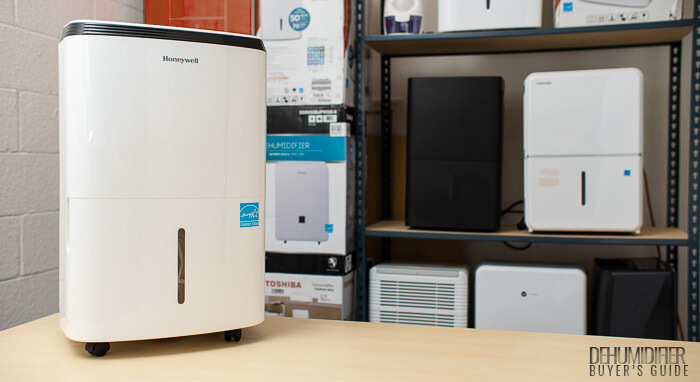
- Front humidity display is a very helpful extra feature unique to this Honeywell dehumidifier
- Included gravity drain hose is another welcome bonus
- Solid performance in our energy efficiency and moisture removal testing
- Highly accurate built-in hygrometer
- Louder compressor buzzing noise than most other 50 pint units we tested
- Only average build quality with somewhat dated design
- Only average bucket size
- Control panel could have better labeling
- Dehumidifier
- Gravity Drain Hose
- Instruction Manual
| Energy Efficiency | 4.0 |
| Noise Output | 3.0 |
| Moisture Removal | 4.0 |
| Hygrometer Accuracy | 4.5 |
| Durability | 3.5 |
| Adjustability | 3.5 |
| Versatility | 5.0 |
| Extra Features | 4.5 |
| Ease of Use | 3.0 |
| Portability | 4.0 |
| Warranty | 4.0 |
| Value | 3.5 |
| Editor's Score | 4.3 |
Quick Review Summary
The Honeywell TP70WKN was formerly a 70 pint dehumidifier. Today, according to new standards for specifying dehumidifier capacity, it is only a 50 pint dehumidifier.
Note that this is still a high capacity dehumidifier. There are no new 70 pint dehumidifiers that are rated for 70 pints/day of moisture removal under new standards. The highest capacity consumer grade dehumidifier you can buy is now a 50 pint dehumidifier – just like this Honeywell.
Also note that the TP70WKN is identical to the TP70PWK except for the fact that the latter unit has a built-in pump and a slightly different control panel. In most other aspects – in terms of energy efficiency, noise output, etc. both units are identical so most of this review applies to the TP70PWK just as much as it applies to the TP70WKN.
This Honeywell dehumidifier performed quite well in most of our hands-on testing. The one exception was noise output testing. We discuss its performance in these tests in detail in the review that follows below. We also go over all of its features and functionality and how it compares to the other 50 pint dehumidifiers we’ve tested.
Note that we wrote most of the review below when the Frigidaire FFAD5033W1 was our top pick, before we tested the Midea Cube. For this reason, we mostly compare the TP70WKN to the FFAD5033W1 (not the Cube) in this review.
Performance Test Results
Energy Efficiency
The Honeywell TP70WKN drew slightly less power than most other 50 pint dehumidifiers we tested. The Honeywell drew 563 watts while most other units drew approx. 570 watts. The most power hungry 50 pint units drew up to 610 watts.
The Honeywell was an average to above average performer in our moisture removal tests – it lowered room humidity just about as fast or slightly faster than the average 50 pint dehumidifier we tested.
With a below average power draw and an above average moisture removal rate the Honeywell has above average energy efficiency according to our testing.
Noise Output
The Honeywell exhibited a slightly more pronounced compressor buzzing noise than most other 50 pint units we tested, especially for a top exhaust unit (the Honeywell exhausts through the top of the unit right in front of its control panel).
Many other top exhaust units, like the top rated Frigidaire FFAD5033W1, were able to mask compressor noise very well, mostly because of their top exhaust. The exhaust outputs a “wind” noise that’s essentially a white noise. An upward facing exhaust better distributes this white noise than a side exhaust (such as what we see on units like the hOmeLabs HME020031N). Thus top exhaust units have an advantage over side exhaust units in masking compressor noise.
Despite this advantage (i.e. despite its upward facing exhaust), the Honeywell exhibited substantial compressor noise, even on high fan speed.
In terms of raw noise output the Honeywell performed slightly better than most other top exhaust units we tested. Ten feet away from the dehumidifier raw noise output was measured at 53.3 dB on high fan speed and 49.2 dB on low. For comparison, the top rated Frigidaire was measured at 54.6 dB and 49.8 dB in the same tests.
Thus, the combination of fan noise and compressor noise amounts to lower noise output for the Honeywell compared to the other top exhaust units we tested. The problem is that the fan noise is too low relative to the compressor noise. And so the actual quality of the noise the Honeywell produces is worse (i.e. is less pleasant to listen to) due to its especially loud compressor.
Note that side exhaust units have even lower raw noise output than the Honeywell. But all of them suffer from the same problem as the Honeywell – fan noise is too low compared to compressor noise which makes for a poor (unpleasant to listen to) noise output profile. Such is the case for the “quietest” dehumidifier we tested – the hOmeLabs HME020031N.
If you want a dehumidifier with a pleasant noise output profile, look for a unit with a top exhaust (to better mask compressor noise) and low compressor noise (relative to fan noise). This describes the top rated Frigidaire FFAD5033W1.
Moisture Removal
50 pint dehumidifiers are specified by manufacturers to be able to remove 50 pints of moisture per day at 65° F and 60% relative humidity (RH).
Our moisture removal tests involve measuring how long it takes these units to lower room humidity from 90% down to 40% RH and then from 80% down to 40% RH. All of this is done at approx. 80° F in a 50 sq. ft. room.
In the first test the Honeywell took an average of 10 minutes, 43 seconds to lower room humidity from 90% down to 40% RH. This was an average result compared to most other 50 pint units we tested (i.e. most other 50 pint units also took right around 10 to 11 minutes). The stand-out in this test was the top rated Frigidaire which only took 7 minutes, 56 seconds.
In the second test the Honeywell took an average of 5 minutes, 31 seconds to lower room humidity from 80% down to 50% RH. This was a slightly above average result. Most 50 pint units took closer to 6 minutes, on average, in the same test. The top rated Frigidaire was again an exception with a time of only 5 minutes, 19 seconds.
Hygrometer Accuracy
The Honeywell exhibited the best hygrometer accuracy of any dehumidifier we’ve tested in the last several years. It was accurate to within 1% of actual room humidity. For comparison, the top rated Frigidaire and hOmeLabs units were accurate to within 2 to 3%.
The implication here is that the Honeywell will work very well on “manual” mode. When set to lower room humidity to 50% RH, for example, the unit will only cycle off when actual room humidity is within 1% of 50% RH.
Units with less accurate hygrometers may shut off prematurely. For example, a unit that reads 50% when the actual room humidity is 55% will shut off at an actual room humidity of 55% when set to 50%.
Included Features, Functionality, Build Quality, Warranties, and Value
Durability (Build Quality)
General Impressions
The Honeywell features average build quality compared to most other 50 pint dehumidifiers we’ve tested.
Consumer Feedback
Consumer feedback for this unit is mostly positive. This unit has less complaints about the unit being DOA, error codes, etc. than what we see in reviews for most other 50 pint dehumidifiers we’ve surveyed.
Overall Category Score
The unit earns an average 3.5/5 for durability.
Adjustability
This unit features the same “manual” mode as every other 50 pint dehumidifier we’ve tested. You can set a desired humidity level in 5% increments. When the desired humidity level is reached, the unit automatically cycles off until room humidity rises back up above the set level.
The unit can also be set to continuous mode, in which case it will run non-stop until you manually turn it off. This is an industry standard setting – in other words, all 50 pint dehumidifiers come equipped with this setting.
The unit doesn’t feature an auto mode but we don’t deem such a mode necessary as “manual” mode already automatically cycles the unit off when the desired humidity level is reached. The only thing that an “auto” mode does is set a “comfortable” humidity level for you. It’s easy enough to determine which specific humidity level is comfortable for you and set that level “manually” on the unit’s “manual” mode.
The Honeywell features 2 fan speeds. Some units feature 3 but you’ll rarely want to run the dehumidifier on any speed other than high since a. the unit will remove moisture faster on high and b. the unit will produce a more pleasant noise output profile on high (on this setting fan noise better masks compressor noise since the fan noise is louder).
The unit also features an industry standard timer that can be set in half hour increments up to 10 hours and 1 hour increments past 10 hours up to 24 hours.
Overall Category Score
As was true for durability, the Honeywell doesn’t do anything special in the category but doesn’t do anything especially poorly either. It earns an average 3.5/5 for adjustability.
Versatility
Set Humidity Range
On the unit’s aforementioned “manual” mode you can set a desired humidity level between 30% and 90% relative humidity (RH). This is a larger range than what you’ll find on most other 50 pint dehumidifiers on the market. Most other units can only be set to as low as 35% RH or as high as 85% RH.
You’ll rarely want to set the unit to as high as 90% RH so the unit having a higher top end to the range isn’t much of an advantage.
However, being able to set the desired humidity level to as low as 30% RH is definitely a positive as there are some instances where you may want room air to be as dry as 30% RH.
A unit that can only be set to as low as 35% RH can still lower room humidity down to 30% RH (and even lower than 30% RH) but you would need to set it to continuous mode for it do so. So, let’s say you have a unit that can only be set to 35% RH and you want a room humidity of 30% RH. You would set the unit to continuous mode and eventually room humidity would reach 30% RH. But you would need to monitor the humidity level in the room yourself and manually turn the unit off at 30% RH if that’s the humidity level that you want.
With the Honeywell you can set it to 30% RH and it will automatically shut off at 30% RH. It will then automatically cycle back on when room humidity goes back up above 30% RH.
Operating Temperature Range
The Honeywell has an industry standard manufacturer specified operating temperature range of 41° F to 89° F.
Gravity Drainage
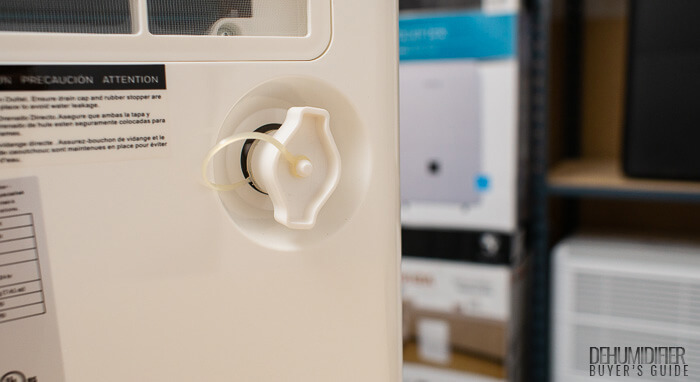
This unit collects moisture in a bucket just like every other compressor based dehumidifier on the market.
It can also redirect that moisture through a drain outlet like every other compressor based dehumidifier on the market.
The difference with the Honeywell, is that it comes with a gravity drain hose. Most other 50 pint units do not come with hose. You have to supply and connect your own garden hose to employ gravity drainage.
The Honeywell’s included hose (in the photo below) is 3.28 ft. (1 meter) long and requires the use of an included specialty drain cap. The hose and cap are very easy to install. Simply remove the standard drain cap (in the photo above) and install the specialty drain cap with connected hose.
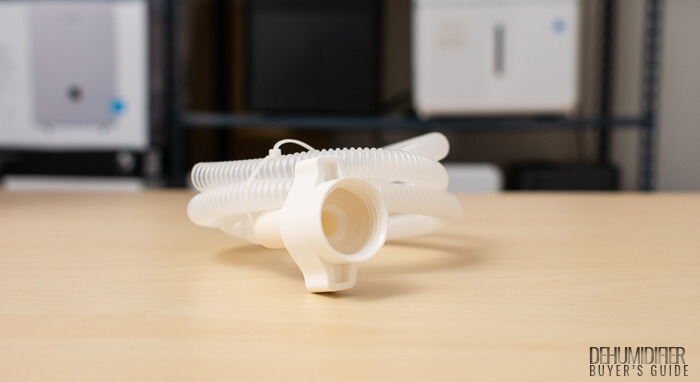
Built-in Pump
The TP70WKN does not come with a built-in pump but Honeywell does manufacture a built-in pump equivalent – the TP70PWK. The built-in pump model features an almost identical design, size, features, etc. to the non-built-in pump model. It simply adds a built-in pump.
Overall Category Score
The unit’s extended set humidity range and included gravity drain hose earns it a perfect 5/5 in the category.
Extra Features
Front RH Display
Every compressor based dehumidifier we’ve tested displays the current room relative humidity (RH) on its control panel. This Honeywell dehumidifier is the only one to also display this information on its front panel.
This is a very helpful extra feature for the unit to have. With other dehumidifiers you have to walk right up to the unit to see its reading of current room humidity. With the Honeywell you can monitor RH from a distance away.
Temperature Reading
This unit does not display room temperature.
Defrost
This unit features a defrost mode but no defrost indicator light.
Check Filter
The Honeywell does feature a check filter light.
Overall Category Score
The unit earns an above average 4/5 in the category.
Ease of Use
LED Display Clarity
The unit’s LED display is not the best quality but it is adequately clear and easy to read.
Setup Difficulty
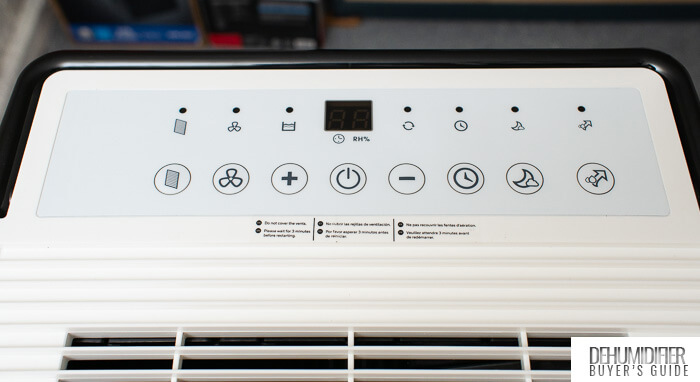
A few of the 50 pint units we tested have control panels with no text labels. The Honeywell TP70WKN is one of such units (note that the built-in pump version’s control panel is shown above – it has one extra button and indicator light on the far right but otherwise has an identical control panel).
Most of the buttons and indicator LEDs are self-explanatory – a graphic on the button or next to the light is sufficient. However, certain functionality is not adequately explained with a graphic/icon. It’s likely that new users will need to reference the unit’s included manual to figure out what certain buttons do and what certain LEDs turning on actually means. The same is not required for dehumidifiers that have control panels with text labels.
Filter Removal Difficulty
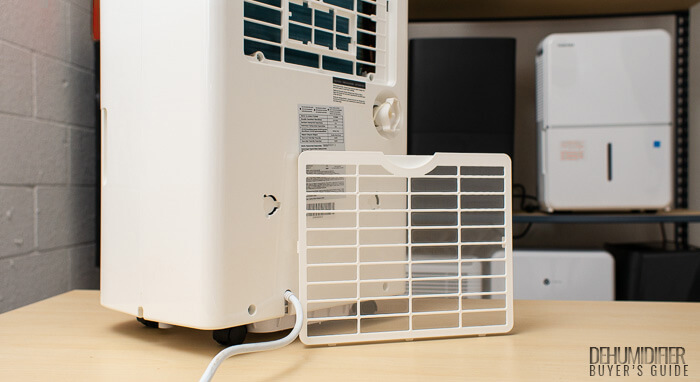
The unit’s intake air filter is easily accessed on the back of the unit.
Manual Clarity
We have no complaints regarding the included manual.
Water Tank Size
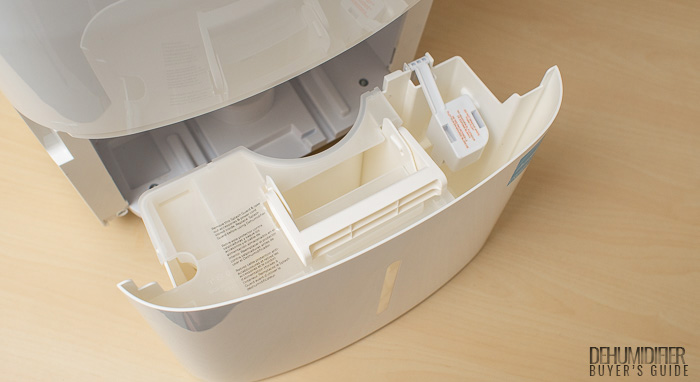
The Honeywell collects moisture in a bucket (water tank) that fits into the front and bottom of the dehumidifier. The size of this bucket determines how often you’ll need to empty it. The larger the bucket, the better.
Unfortunately, the Honeywell has only an average sized bucket – it has a capacity of only 14 pints. Top rated units like the Frigidaire FFAD5033W1 have a bucket with a capacity close to 17 pints (the Frigidaire’s bucket has a capacity of exactly 16.9 pints).
Overall Category Score
A poorly labeled control panel and average bucket size gives the Honeywell a slightly below average 3/5 in the category.
Portability
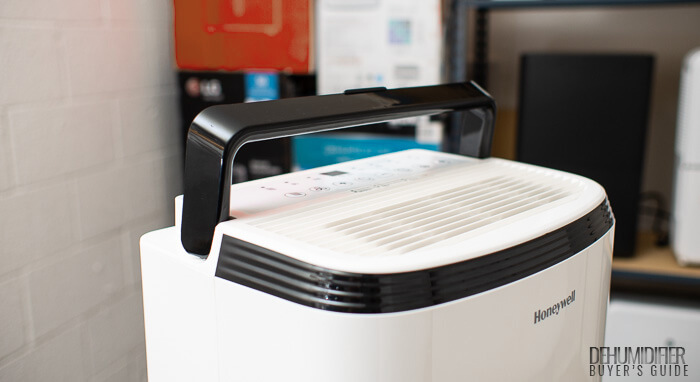
The TP70WKN weighs 42.9 lb. which is just about the average weight for a dehumidifier in the 50 pint size class.
All dehumidifiers come with either side pocket handles or a top handle. We prefer the top handle. And the Honeywell does come with a top handle.
The Honeywell requires you to install two plastic hooks (see photo below) on the back of the unit to enable proper cord storage (you can wrap its power cord around these hooks). Many other dehumidifiers require you to install some type of cord storage assembly as well. Some do not. Either way, the hooks are easy to install and once installed they work well.
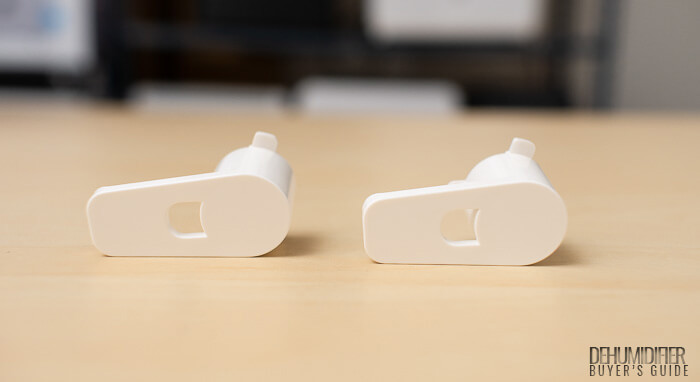
Overall Category Score
The Honeywell earns a slightly above average 4/5 in the category.
Warranty (Manufacturer’s)
The industry standard dehumidifier warranty covers all components for only 1 year. The same applies here. The included warranty covers all components for only 1 year.
However, the included Honeywell warranty also adds an additional 2-5 years of coverage for the unit’s sealed system (compressor, condenser, etc.). This is something we do not see with most other 1 year dehumidifier warranties.
The best included warranty currently available belongs to hOmeLabs compressor based dehumidifiers. They come with a 2 year warranty that covers all components. You can also add 6 months to the warranty by registering your purchase with the manufacturer.
Value
The TP70WKN’s price varies greatly but it does tend to lean towards being on the more expensive side for a 50 pint dehumidifier. Considering this unit’s performance in our hands-on testing, all of its features and functionality, and how all of that compares to what the competition has to offer, we consider this Honeywell dehumidifier to be only an average value compared to all of the other 50 pint dehumidifiers we’ve tested.
Have a question or comment? Let us know below.
When I received my Honeywell TP70WKN dehumidifier in the mail, I noticed the box was damaged and after unpacking, one of the wheels was in pieces. I contacted Honeywell asking to replace the wheel. They said to return the unit, but I thought it was just a wheel problem and used something to keep it level. My mistake. The humidifier does not work and when trying to address this problem the next thing I knew, I was being charged $40/mos. for nothing. I don’t think a company should be allowed to be so dishonest.
I would like to comment on your Frigidaire rating.
I have owned 3 70 pint models in the past 6 years. All failed. The first was recalled in the 3rd year. The replacement lasted 2 years (refrigeration leaked out).
The 3rd lasted one year the coils froze up one month after the 1 year warranty expired. I made many attempts to work with customer service and they refused to give me any relief on the warranty service. I wrote a letter to the president of the company and never even got a response. If you look at Amazon comments you will find similar complaints. I think you may have over rated Frigidaire. I’m no longer a customer. Thank you for your complete review. I am going to use it to buy a one of the other highly rated units.
Hi
My new honey well dehumidifier with the pump-makes garage more hotter
Blows out lot of hot air
Why?
I have purchased and returned two units last month because they came with a defective sensor and the fan never shuts off after reaching the set humidity level. When the compressor / water collection stops, the fan is supposed to stop about 3 to 5 minutes after, but the fan keeps running and does not stop.
Just bought this same unit and turned it on today and noticed the same thing – the fan does not shut off. My unit’s RH gauge is within 5-6% of a stand alone hygrometer so it’s “close enough”. The compressor does cycle on and off to keep the humidity within the set range (though I’ll need to spot check that some more to make sure about that +/- 5% range the manual indicates).
The fact that the fan doesn’t shut off is a disappointment. It’s after business hours now so I’ll call CS tomorrow and see what they have to say. Bought it from Home Depot so I can return it if other problems develop within the return period.
Worked well for six weeks and then quit. I emptied the bucket, cleaned the filter, and unplugged the unit in hope of a restart. Lights seem to work fine. Nothing works and the owners manual is basically insulting as it indicates that if the unit doesn’t work it must be unplugged. Not real helpful.
We purchased the Honeywell dehumidifier model TP7QWKN
In spring 2020, used all summer and stored in the finished basement last winter. It was working fine when we stopped using
last summer and now it runs, sounds fine, but is removing no moisture from the room. No water in bucket at all. Filter is clean and it looks brand new. What’s wrong and how to we fix??
Does the defrost mode, even though no light to indicate it is working, actually work? And can a regular garden hose be hooked up instead of the short hose that comes with it? Need a 15′ hose that has worked well for last gravity dehumidifier.
What does a built in pump do and what would the advantages of having one be?
A built-in pump allows the unit to pump collected moisture to a location above the dehumidifier. Without a pump the unit can only drain to a location below the dehumidifier.